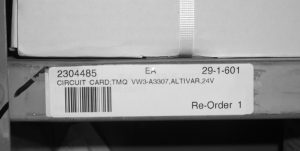 This article discusses:
This article discusses:
- Why Your Spare Parts Data Will Lose Integrity
- The Key to Spare Parts Inventory Data Governance
- The Requirements of a Data Governance Solution
Why Your Spare Parts Data Will Lose Integrity
No matter how well the spare parts identification system is set up, without an appropriate spare parts inventory data governance structure and process, the information that you have will lose integrity.
Sometimes this happens when implementing a new ERP system, due to companies’ not providing sufficient time and budget to properly map the data fields.
Sometimes it happens during a company merger where there is an attempt to merge two spare parts databases.
More often, however, it happens because companies don’t instil the appropriate discipline to ensure adherence to a standard approach.
The result of this is an inability to identify the parts already in the system, and this leads to extended downtime, unnecessary purchases, and inventory duplication.
Whatever the reason, your organization is very likely to invest in its materials data and data management systems at some point, and while the payback is big, it can be a significant, resource-draining project, and it is very easy to get wrong. This article identifies the key decisions that will enable you to make sure that your newly cleaned data stays clean.
The Key is Spare Parts Inventory Data Governance
After you’ve employed the best services partner and used the right data cleaning application to deliver a set of well-organized, clean materials data, how are you going to maintain all that information and make sure that your data doesn’t get corrupted, causing you to start all over again? The key is spare parts inventory data governance.
Putting in place the right governance process and software application is crucial—and it must be a combination. Data governance across a large organization with many languages and ERP systems can be achieved, but only with a very capable software application backed up by the business processes and organization to apply it.
Requirements of a Data Governance Solution
Every good consultant will tell you that the starting point is to understand your current processes and define what you need to control.
This is an important step, but care must be taken not to define an entirely customized process that requires lots of expensive development and implementation.
You might save a great deal of time and money by finding a solution that already has the flexibility to map in your required processes through simple configuration.
Your chosen solution should handle the requirements of creating a single item, internationally, across multiple languages, dealing with the complex work flow and approval processes required by the end users of materials, where inaccuracy is much costlier than a misspelled address.
The solution needs to be capable of controlling the entire creation and modification process—from the initial request for a new master item originating from the factory floor to the addition of the item to whichever enterprise system needs it.
This includes ensuring it is not a duplicate, recording the descriptive information consistently, adding all the other data associated with materials such as accounting codes and logistics information, and tracking this process all the way.
Further, if you operate with multiple ERP or CMMS systems, your governance or MDM application has to handle all the different fields in each application and make sure descriptions are optimized to use the space available for each system.
Finding an application with all these capabilities embedded, off the shelf, will allow you to focus on the crucial organizational changes and staff management issues of implementing a centrally controlled data hub and then exploiting the many significant benefits that suddenly become possible.
Spare Parts Inventory Data Governance: Hard to Get Right But Worth It
Data cleaning and governance projects are hard to get right, and many companies have wasted a lot of money failing to do so, but clean materials master data is the foundation on which considerable business intelligence rests. Getting it right can open up a myriad of opportunities and will save you much, much more than it costs.
For information on our Pro Level membership please visit our Pro Level page.
Posted by: Phillip Slater